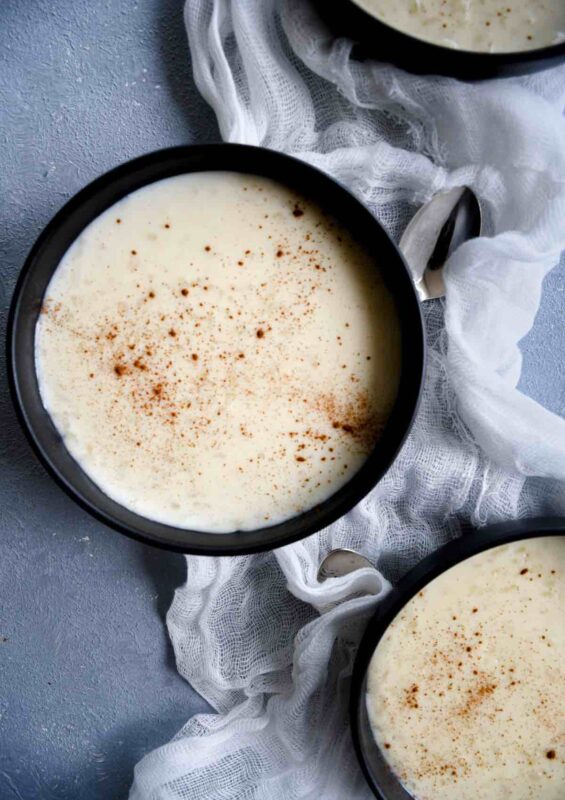What Is Rice Pudding?
Rice pudding is a creamy and comforting snack or delicious dessert made with whole milk, oat milk, coconut milk or almond milk and short or medium grain rice. Rice pudding is sweetened with white granulated sugar, pure vanilla extract, and warm spices like cinnamon, nutmeg or allspice and cooked in a pot on a stovetop or baked in the oven.
As the rice cooks with the milk, the pudding thickens and to a creamy consistency. Optional add-ins include raisins, craisins, chocolate chips, sliced almonds, or citrus zest.
For best results, rice pudding is often made with short grain or medium grain white rice. Some rice varieties include Kukuho Rose, arborio, or other rice that has a high starch content. Brown rice, however, will change the texture and consistency of rice pudding.
If you’re looking for an authentic homemade rice pudding recipe, this creamy rice pudding recipe is for you! Or, here is a recipe for a dairy-free rice pudding made with oat milk.
You may have made a large batch of rice pudding in advance, or maybe you have leftover rice pudding that you’re looking to freeze. Freezing is a great option to extend the shelf life of rice pudding, and then you can dethaw smaller amounts when you’re ready to enjoy it at a later date!

Can You Freeze Rice Pudding?
Yes, you can! Although, as with most foods (except for ice cream, haha), rice pudding does taste best if enjoyed within a day or two of when it’s made. In order to get the best results when freezing rice pudding, you’ll want to follow a few tips.
First, it’s a good idea to portion out the rice pudding into freezer-safe containers before placing them in the freezer. This will make it easier for you to take out just the amount you need instead of de-thawing a whole pot of rice pudding.
I would also recommend labelling your rice pudding with the name and date so that you know when it went in the freezer.
How To Freeze Rice Pudding?
- Allow the rice pudding to come to room temperature.
- Label and date the airtight containers that you will be placing the rice pudding in.
- Portion the rice pudding into individual servings. The amount of rice pudding you place in each airtight container is up to you. But it’s good to think about how much you’ll eventually want to de-thaw at one time. It’s also a good option to leave about an inch of space at the top of the container in case the rice pudding expands as it freezes and dethaws.
- Before placing the rice pudding in the freezer, ensure that the container or freezer bag is sealed correctly. Any exposed rice pudding may get freezer burn, and it won’t last as long in the freezer or taste as good once it’s dethawed.
- You can store the rice pudding in the freezer for up to two months. But, the less time in the freezer, the more delicious your rice pudding will be.
How Long Can You Freeze Rice Pudding?
Rice pudding can last in the freezer for up to two months. The type of milk used for rice pudding may also affect the length of time it can last in the freezer. Milk doesn’t always freeze well, so there may be some separation when you dethaw the rice pudding. There are so many milk substitutes, so depending on if you’re using coconut milk, oat milk, or almond milk, the pudding may separate more or less.
The type of milk will also change the creaminess of the rice pudding. For instance, rice pudding made with whole milk or heavy cream will have more of a creamy texture compared to a pudding made with coconut milk. You’ll also want to make sure you’re placing the rice pudding in a freezer-safe container.
How To Thaw and Reheat Rice Pudding?
The best way to dethaw rice pudding is to remove the rice pudding from the freezer and place it in the fridge to dethaw overnight. The amount of time it takes for the rice pudding to dethaw in the fridge will depend on the amount of rice pudding in the container.
It’s important to note that you shouldn’t dethaw rice pudding at room temperature on your kitchen counter. This will increase the amount of bacteria and could cause your rice pudding to spoil.
After your rice pudding has thawed in the fridge overnight, you can reheat the rice pudding in the microwave or in a saucepan on the stove. Before reheating, your rice pudding will be cold, but it shouldn’t still be frozen. If that’s the case, allow it to dethaw for a little bit longer in the fridge. You may need to add a tablespoon or two of milk or cream to your rice pudding when reheating.
You can reheat rice pudding on medium-low heat in a small saucepan on the stove. It’s a good idea to stir the rice pudding often so that it doesn’t stick to the bottom of the saucepan. At this stage, you can add raisins, nuts, or your favourite fruits. I also like to sprinkle rice pudding with cinnamon!
What Are The Disadvantages of Freezing Rice Pudding?
The rice pudding’s texture will change slightly after being frozen and then thawed. There may also be a bit of separation when freezing rice pudding because of the dairy in the pudding.
As mentioned above, if you’d like to add raisins or fresh fruit to your rice pudding, you may be better off not adding those until you’re reheating the frozen rice pudding.
What Are The Advantages of Freezing Rice Pudding?
Rice pudding can last in the refrigerator for up to four days if you’re storing it correctly. For this reason, you may want to freeze the rice pudding so that it lasts longer. In addition, if you’re making a large quantity of rice pudding, then freezing the leftovers may be your best bet for long-term storage. Portioning the rice pudding into individual portions can make it convenient to enjoy rice pudding when you’re looking for a sweet treat.
Date Published: June 16, 2023

This post is very helpful! Thank you. I just have to comment on the use of the word “dethaw”! I hadn’t heard of this before but perhaps it’s more widely used in other parts of the country. Since ‘thaw’ means to take something from frozen to non-frozen, “dethaw” sounds like it should mean to freeze something. Lol just had to say something. I believe the correct terms are “thaw” and “defrost”.